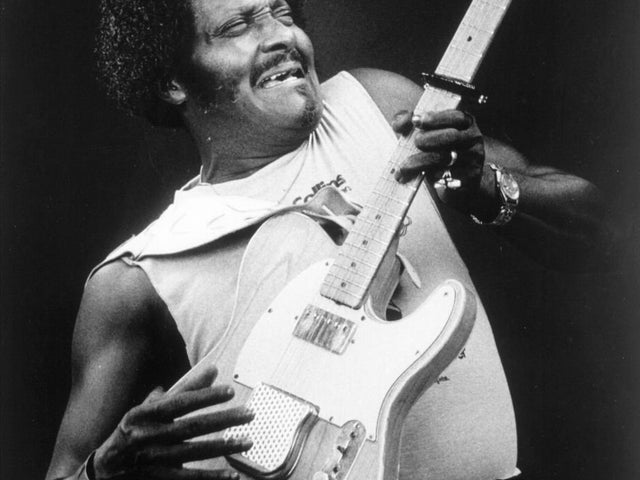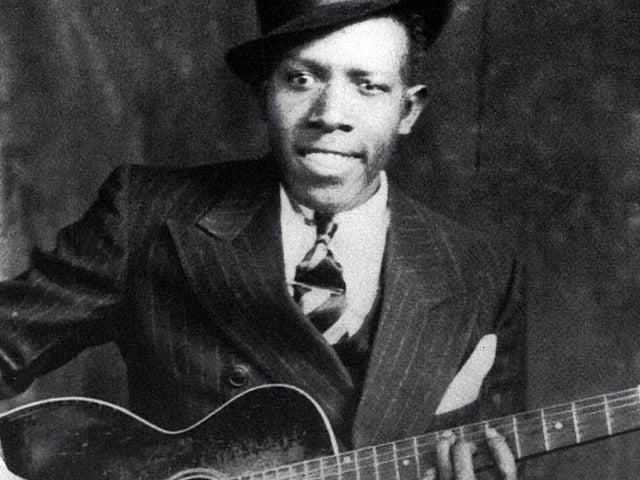The Rolling Stones have been a band since 1962. That’s longevity, people! These guys love their job so much they’re still out there after 55 years putting on great shows; there’s a distinct possibility that when Mick Jagger or Keith Richards finally kick the bucket, it’ll be on stage. The band took a love of blues, R&B, and early rock ‘n roll, scoffed at their blues purist peers, and spat back out their own version of American-inspired music, setting themselves apart from their British Invasion contemporaries. To further help distinguish the band from those clean-cut groups with their matching suits, the Stones’ then manager carefully cultivated their bad-boy image, emphasizing their scruffiness and antics. Young fans may have wanted to take the Beatles home to their parents, but Stones fans wanted to be with them in the backseat of their cars.
The Stones weren’t so much interested in shining a light on puppy-dog love as excavating the dirty underbelly of lust and vice, trying to stay true to their R&B influences and creating a rock sound that is distinctly their own. I’ll admit that I was once blinded by my Beatles fandom to the brilliance of the Rolling Stones. But then I listened to Sticky Fingers and Let It Bleed and like a thunderbolt I was hit with the knowledge that these guys rock. Like seriously rock. Like this is sex, drugs, and rock ‘n roll incarnate and oh my god, is Mick singing about someone creaming all over him (“Let It Bleed”)? With over two dozen studio and live albums to choose from, there are many essential listens ranging from good to holy-shit-spectacular so narrowing down to 10 is no easy feat. But in terms of physical ownership, your collection will thank you for any of the listed ones below. World’s greatest rock ‘n roll band? Judge for yourself.

England’s Newest Hit Makers (1964)
Mick Jagger, Keith Richards, Brian Jones, Bill Wyman, and Charlie Watts exploded onto the scene with their 1964 American debut album, England’s Newest Hit Makers (known as The Rolling Stones in the UK). Consisting of mostly covers, the American version of the album starts with opener “Not Fade Away,” a Buddy Holly cover which in turn is very reminiscent of Bo Diddley, who was an early hero of the band. This one song pretty much sums up the Stones; by upping the Bo Diddley beat on this cover they slyly acknowledge they’re a bunch of white kids emulating black music, and on the rest of the album prove their sincerity by paying tribute to other blues, rock, and R&B heroes like Willie Dixon (“I Just Want To Make Love To You”), Muddy Waters (“I’m a King Bee”), Chuck Berry (“Carol”), and Rufus Thomas (“Walking the Dog”). Jagger and Richards hadn’t quite established themselves as a strong songwriting team at this point (only three of the twelve tracks are originals) but “Tell Me” is a pop rock highlight. The unpolished raw energy of the album, as well as their unique bad-boy image, won over fans and was the start of a long (LONG) music career.

Aftermath (1966)
You can’t go wrong with either the UK or US version of 1966’s Aftermath, since this album kicks ass with either tracklisting. But in the interest of brevity I’ll just talk about the US version. Recorded entirely in Hollywood, Aftermath is the Stones at their most fully formed. No longer reliant on covers filling in around their songs, Mick and Keith are a confident songwriting team and for the first time fill an entire album with their originals. Their focus on arrangements along with Brian Jones’ experiments with instruments like sitar, marimba, and the dulcimer add greater complexities to the music. Blues and early rock influences remain but there’s also pop and everything else happening in the mid-60s. “Paint It Black” opens the album with that familiar riff on sitar, leading into a hard-hitting song about depression and isolation. Getting the upper hand in a relationship is celebrated on “Under My Thumb” which features marimba throughout, giving it a kind of psychedelic feel. The dulcimer gets used on the English folk of “Lady Jane” and on the delicate pop song “I’m Waiting.” This versatility meant the Stones were no longer just a blues rock band but a force in pop music.

Beggars Banquet (1968)
After spending the previous few years flirting with baroque pop and psychedelia, Beggars Banquet was hailed as a return to their blues rock roots in a late ‘60s that had seen civil unrest in the US and the MLK and Kennedy assassinations. With the increasing instability of founding member Brian Jones, Keith stepped in and incorporated a more hard-edged sound which matches their preferred original cover art of a dirty bathroom wall. Album opener “Sympathy for the Devil,” with its exciting congas and provocative lyrics (hey, a rock ‘n roll song that really is about the devil), sets an aggressive tone but then it’s followed up by acoustic blues (“No Expectations”) and bluegrass (“Dear Doctor”) numbers. But if you think you’re going to get out of this album without hearing rock music, think again because “Jigsaw Puzzle” and political song “Street Fighting Man” will knock you out with lyrics like “hey, think the time is right for a palace revolution/but where I live the game to play is compromise solution.” Beggars Banquet began a four-album run that most fans refer to as the band’s golden age in which they lay stake a claim to the title, “greatest rock ‘n roll band.”

Let It Bleed (1969)
Released in late 1969, Let It Bleed saw the Stones closing out a decade where Swinging London and the Summer of Love was now a distant memory and the war in Vietnam was on television. The album continues what they started on Beggars Banquet and drips sex and blood. Rock ‘n roll swagger combines with country blues on stories that are grimy and dark. Eerie album opener “Gimme Shelter” imagines a world closing in which spirals into one of the greatest rock songs of all time (Merry Clayton’s singing on this is worth the price alone) then segues to saying goodbye to a love in the brilliant Robert Johnson cover of “Love in Vain.” Then they drink their way through bars (“Country Honk”) and make suggestive overtures in “Live With Me” and “Let It Bleed.” “Midnight Rambler” menaces with impending violence (those tempo increases add to the tension) and epic album closer “You Can’t Always Get What You Want” is about resigning yourself to keep fighting life’s punches, starting in a somber mood then it builds to an all-out party of the kind of frenetic optimism that can only be experienced by those who truly don’t know what comes next.

Get Yer Ya-Ya’s Out! (1970)
Get Yer Ya-Ya’s Out! is a live album recorded in late 1969 during their American tour where songs are mainly pulled from Beggars Banquet and Let It Bleed allowing for a terrific live document of the Rolling Stones in what is arguably their prime (and a month before the tragedy at Altamont). This tour also marked the addition of guitarist Mick Taylor to the lineup, having replaced the late Brian Jones earlier in the year during the Let It Bleed sessions. With most of the ten tracks recorded over two nights at Madison Square Gardens, the performance is tight with Mick Jagger’s smoldering vocals matched by the pure fire that is the guitar playing on this album. Keith Richards and Taylor just absolutely kill it with notable highlights being “Sympathy for the Devil” and “Street Fighting Man.” The epic version of “Midnight Rambler” is so good it was put on the Hot Rocks compilation. There may be more sought-after live bootlegs from this time period but as far as official live albums go, this is one of the best ever.

Sticky Fingers (1971)
Relieved to be free of their contract with Decca/London, the band established their own label, Rolling Stones Records, and the famous “tongue and lips” logo then they kick open the decade with Sticky Fingers, with cuts ranging from bluesy-country rock and straight blues to latin influences and soul, and further builds on their reputation for in-your-face songs about sex and drugs (look at that Andy Warhol cover art!).The lascivious “Brown Sugar” starts the album with lyrics about slavery and sex and if it didn’t rock so hard, I doubt we’d still be hearing it on the radio today. Underrated rocker “Sway” has an epic outro guitar solo courtesy of Mick Taylor. Another album highlight is “Can’t You Hear Me Knocking” which is an outright jam, culminating in dreamy sax and guitar solos and latin rhythms. Backing up the swagger is a serious effort on their craft with the blues cover of “You Gotta Move,” the soulful “I Got The Blues,” and the well-known ballads “Wild Horses” (a country-rock masterpiece) and “Moonlight Mile.” The latter song is a classic about being tired of all the fame (or coming down from a cocaine high, take your pick) which has Jagger ditching all the posturing in favor of lyrics which are more pained and revealing.

Exile on Main St. (1972)
Exile on Main St. is a sprawling double-LP featuring rollicking rockers, country rock, and sun-washed gospel and marks the last of the Stones’ golden age albums. Living as tax exiles in France, the story goes that the bulk of recording took place in the basement of Keith’s rented villa in the last half of 1971, where the booze and drugs flowed freely. Mick’s newlywed status meant that he wasn’t often in attendance so Keith’s devotion to American roots music largely influences the album, especially on songs like “Shake Your Hips,” “Sweet Virginia,” “Casino Boogie,” “Tumbling Dice,” and “Happy” with Keith on lead vocals. Recording continued in Los Angeles where Mick adds his stamp to the arrangements, adding overdubs and gospel influences. “Tumbling Dice,” the only single off the album that made the top 10, benefits from the additional tinkering; about a roving gambler, it makes you want to roll down all the windows and take a detour on a country highway. But it’s not really about hits with Exile. The impact is best felt when listening to it as a whole, the lyrics secondary to the overall feel of primal need, rock ‘n roll excess, and the tension of a band on the edge of falling apart. The recent 2016 half-speed remaster is serviceable but a quality early ‘70s pressing is preferred.

Goats Head Soup (1973)
Due to various drug-related legal entanglements the band went to Jamaica for the Goats Head Soup recording sessions. The Stones come down from the drug excesses of Exile on Main St. and jump into glitzy studio mode by incorporating glam and funk elements like on “Dancing with Mr. D” and “100 Years Ago.” It is also more ballad-heavy with Mick and Keith in a duet on “Coming Down Again” about stealing a friend’s girl and then Mick lets a girl down gently on “Angie.” But “Doo Doo Doo Doo Doo (Heartbreaker)” and the lurid “Star Star” snarl enough to remind you that this is still the Rolling Stones and no one explores the darker side of human nature better. Very different from Exile, the album got mixed reviews upon initial release despite generating a hit single in “Angie,” so it doesn’t fall into that much revered golden age but critical regard has improved over time. There are also signs that current vinyl lovers recognize the album’s quality work. According to this article, it was a top 3 favorite vinyl record to buy in multiple states last year.

Some Girls (1978)
By the late ‘70s the Stones had been crossed off the lists of artists that could be considered at the top of their game. Keith was still embroiled in legal problems related to his drug use while Mick seemed more concerned with the celebrity lifestyle than with the responsibilities of a rock band. But the Stones have always known how to incorporate contemporary music trends into their sound, making something recognizable sound relevant. Some Girls is marked by disco and punk influences on songs like their last US number one hit “Miss You,” the hard-driving “Respectable,” and the broken urban dreams of “Shattered.” They can get dirty with “When The Whip Comes Down,” “Lies” and the title track (warning: very cringe-worthy lyrics about women) and a little bit country with “Far Away Eyes.” Richards gets personal in “Before They Make Me Run,” a comment on his legal troubles, and contributes one of their best ballads “Beast of Burden,” where Richards and Ronnie Wood effortlessly trade off guitar licks. A front-to-back solid album that was both a critical and commercial success, Some Girls put them back on top one last time before eventually losing ground to newer and fresher acts in the 1980s.

Blue and Lonesome (2016)
As what frequently happens in old age, people start looking back to the beginning. Music styles and band line-ups change but throughout it all the Rolling Stones have never hid their love for the blues. In fact, most of their albums include a blues or early rock cover. Recorded over three days, last year’s Blue and Lonesome sees the Stones pay homage to these influences (and their own longtime penchant for covers) by bringing it full circle and making a whole album of them. Mostly focusing on Chicago blues, the style the band would play in their early ‘60s club days, there’s also a bit of southern and delta blues (“Hoodoo Blues” and “Everybody Knows About My Good Thing”). The album opens with a Little Walter version of “Just Your Fool,” and the tributes keep coming with covers of legends like Howlin’ Wolf, Memphis Slim, Lightnin’ Slim, Willie Dixon and Otis Rush. Best exemplified by their version of “Ride ‘Em On Down” which features Eric Clapton on slide guitar, the album is a fun ride with some aging rock stars rediscovering and sharing their passion for blues only this time backed up by the wisdom gained through years of mistakes and hard-living. Still full of strut and swagger, the Stones do it their way and don’t give a fuck what anyone else thinks.
Marcella Hemmeter is a freelance writer and adjunct professor living in Maryland by way of California. When she's not busy meeting deadlines she frequently laments the lack of tamalerias near her house.
Join the Club!
Join Now, Starting at $44Exclusive 15% Off for Teachers, Students, Military members, Healthcare professionals & First Responders - Get Verified!







